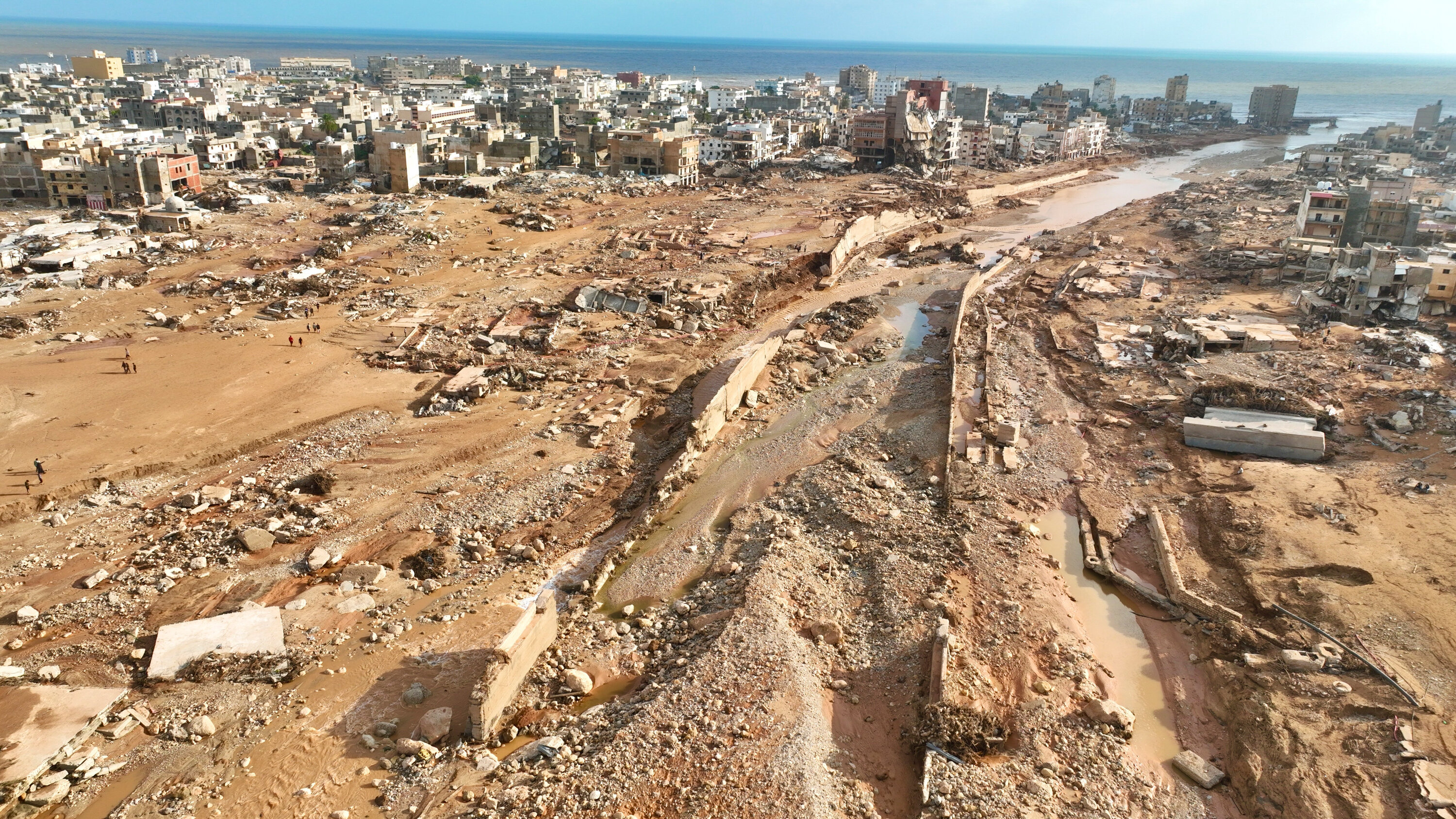International Rescue Teams Seek Urgent Assistance In Retrieving Flood Victims' Bodies In Libya
International rescue teams seek urgent assistance in retrieving flood victims' bodies in Libya. The catastrophic floods, which occurred over a week ago, have left thousands dead, with many of the victims' bodies still submerged in water or located in hard-to-reach areas.
Author:Suleman ShahReviewer:Han JuSep 18, 20235.3K Shares87.7K Views

International rescue teams seek urgent assistance in retrieving flood victims' bodies in Libya. The catastrophic floods, which occurred over a week ago, have left thousands dead, with many of the victims' bodies still submerged in water or located in hard-to-reach areas.
Bodies Decomposing In Water
Rescue teams report that the bodies of flood victims are severely decomposing, and there is growing concern that retrieval may become impossible if immediate action is not taken. Many of these bodies are situated in areas that necessitate specialized equipment for recovery.
In a meeting held with representatives from various missions, including Tunisia, the United Arab Emirates (UAE), Egypt, Algeria, Russia, Turkey, and Italy, rescue teams highlighted the urgency of the situation.
The Tunisian mission's representative emphasized the need for assistance to enhance the efficiency of their intervention.
Mission representatives from the UAE, Egypt, and Algeria reported discovering bodies in bays and coves along the Mediterranean coast, areas accessible only by special boats and divers.
The Algerian team revealed that they spotted approximately 50 bodies from a cliff about 7 nautical miles from the Derna port, underscoring the potential for a more efficient recovery process with the right equipment.
Discrepancies In Casualty Figures
The exact toll from the Derna floods remains unclear, with conflicting reports on the number of casualties. A UN report released on Saturday estimated the death toll at 11,300, with an additional 10,100 individuals reported as missing.
However, Libyan authorities, particularly the healthministry of Libya's eastern government, dispute these figures.
According to the eastern government's health ministry, they have documented 3,252 deaths in Derna, and they assert that the UN's toll is inaccurate, as their figures are based on documented recoveries and burials.
Aging Dams Pose Significant Risks
The tragic dam collapse in Libya, which unleashed torrential floodwaters resulting in significant loss of life, has shed light on a global issue concerning aging dams.
These events were both predicted and preventable, serving as a stark reminder of the urgent need to address aging and obsolete dam structures worldwide.
Many dams worldwide, including those in Libya, were constructed during the dam-building boom of the 1970s.
Now, several decades later, these dams are reaching the end of their intended lifespans. Neglecting maintenance and monitoring of these aging structures has contributed to their deterioration.
The risks associated with aging dams are not unique to Libya. Countries such as India and China, which have a high number of large dams built in the mid-20th century, face substantial risks.
In India, the Mullaperiyar Dam, over a century old and located in an earthquake-prone region, poses a significant threat to downstream populations.
In the United States, where thousands of dams are nearing obsolescence, the average dam age is 65 years old. Approximately 2,200 dams are considered high-risk, requiring an estimated $76 billion in repairs.
The recent infrastructure law allocates $3 billion to address some of these issues, but numerous dams fall outside federal responsibility.
Climate Change Amplifies Risks
The looming danger of aging dams is exacerbated by climate change. These structures were designed to withstand the extreme weather conditions envisioned at the time of their construction.
However, the increasing frequency of once-in-a-century weather events, driven by climate change, poses a grave threat to dam integrity.
While some aging dams still serve vital purposes, such as providing drinking water and supporting agriculture, many dams built for hydropower generation are no longer cost-effective.
Sediment accumulation behind dam walls, coupled with climate-related droughts, has diminished their energy production capacity.
A global movement, often led by Indigenous communities and marginalized populations, is advocating for dam removal and river restoration.
The removal of four dams on the Klamath River along the Oregon-California border, scheduled for completion next year, marks one of the largest dam removal efforts in history.
Embracing River Restoration
Europe is also embracing river restoration projects, recognizing the need to address fragmented rivers and declining freshwater biodiversity.
The River Meuse restoration project in the Netherlands aims to reduce extreme inundation events from once a century to once every 250 years by restoring floodplains.
The tragic dam disaster in Libya serves as a stark warning for the aging dams worldwide, demanding immediate attention and action.
As climate change continues to impact these structures, the removal of obsolete dams is increasingly becoming a critical solution to mitigate risks and safeguard communities and ecosystems.
Final Words
The devastating floods in Derna, Libya, have underscored the urgent need for action on aging dams worldwide. With thousands of lives lost and many more at risk, the tragic event serves as a stark reminder of the consequences of neglecting dam maintenance and monitoring.
Aging dams, like those in Libya, pose significant risks to numerous countries, including India and China. Climate change exacerbates these risks, making dam removal an increasingly vital solution to prevent future disasters.
The global movement for dam removal and river restoration, led by Indigenous communities and marginalized populations, highlights the importance of addressing these aging structures.
As we confront the challenges of climate change and deteriorating infrastructure, it is imperative to take proactive measures to protect our communities and ecosystems from the impending dangers of obsolete dams.

Suleman Shah
Author
Suleman Shah is a researcher and freelance writer. As a researcher, he has worked with MNS University of Agriculture, Multan (Pakistan) and Texas A & M University (USA). He regularly writes science articles and blogs for science news website immersse.com and open access publishers OA Publishing London and Scientific Times. He loves to keep himself updated on scientific developments and convert these developments into everyday language to update the readers about the developments in the scientific era. His primary research focus is Plant sciences, and he contributed to this field by publishing his research in scientific journals and presenting his work at many Conferences.
Shah graduated from the University of Agriculture Faisalabad (Pakistan) and started his professional carrier with Jaffer Agro Services and later with the Agriculture Department of the Government of Pakistan. His research interest compelled and attracted him to proceed with his carrier in Plant sciences research. So, he started his Ph.D. in Soil Science at MNS University of Agriculture Multan (Pakistan). Later, he started working as a visiting scholar with Texas A&M University (USA).
Shah’s experience with big Open Excess publishers like Springers, Frontiers, MDPI, etc., testified to his belief in Open Access as a barrier-removing mechanism between researchers and the readers of their research. Shah believes that Open Access is revolutionizing the publication process and benefitting research in all fields.

Han Ju
Reviewer
Hello! I'm Han Ju, the heart behind World Wide Journals. My life is a unique tapestry woven from the threads of news, spirituality, and science, enriched by melodies from my guitar. Raised amidst tales of the ancient and the arcane, I developed a keen eye for the stories that truly matter. Through my work, I seek to bridge the seen with the unseen, marrying the rigor of science with the depth of spirituality.
Each article at World Wide Journals is a piece of this ongoing quest, blending analysis with personal reflection. Whether exploring quantum frontiers or strumming chords under the stars, my aim is to inspire and provoke thought, inviting you into a world where every discovery is a note in the grand symphony of existence.
Welcome aboard this journey of insight and exploration, where curiosity leads and music guides.
Latest Articles
Popular Articles
